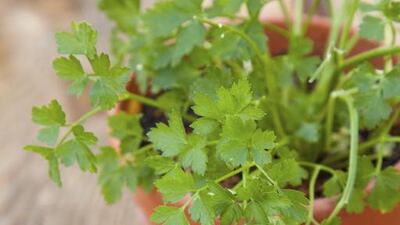Typically used for its seeds and leaves, coriander – or cilantro, as it's referred to in the Americas – can be a tricky herb to grow, but is delicious when incorporated into a variety of recipes.
The herb is normally found in Europe, but is grown everywhere from North Africa to south-western Asia. Because it requires both ample sunlight and milder temperatures, cultivating coriander in the UAE will require close attention. Growing the plants in hot weather will cause them to bolt past harvesting, making the leaves bitter in flavour. Luckily, however, because the growth period is fast, it’s still possible to grow the herb outdoors in this region during the winter months.
Those looking to harvest coriander leaves have three varieties to choose from: Costa Rica, leisure and long-standing. Once you’ve decided which variety to plant, choose a sunny site, either in a herb garden or in the corner of a vegetable garden.
Plant the seeds in light, well-drained soil and space them 2.5 centimetres to 5cm apart, and about 6cm deep, in rows about 30cm apart. The seeds should be sown at two- to three-week intervals for a continued harvest, and it’s important to keep them moist during germination. Plants should be watered regularly – about 2.5cm of water per week will do the trick. Once the seedlings have reached the 5cm mark, watering can be reduced. During this time, fertilise once or twice. This is also the time to prevent overcrowding. To do this, simply pull out the smaller plants and leave the strongest ones to grow larger. You should allow around 20cm to 25cm between each plant.
While keeping coriander, watch out for pests like fungal wilt, leaf hoppers, aphids and mildew. To control insects, use either insecticidal soap (once you have spotted insects under the leaves), or eco-conscious gardeners can mix one teaspoon of real soap with one litre of water. Cleaning up debris and spent plants will also help to avoid wilt and mildew.
Harvest the leaves while the plant is low. Once the stalk grows, cut off the plant after the seeds drop and let it self-seed. If larger leaves are apparent, cut these individually from the plants, while smaller leaves should be cut off 4cm to 5cm above the crown. For those not looking to harvest for the entire growing season, the whole plant can be removed at once. Once the leaves are ready for use, you can begin storing them by freezing or drying. To freeze, place the leaves in a bag and store in the freezer; to dry, simply place the plant in a warm place for as long as needed. From there, store the dried leaves in an airtight bag or container.
Despite coriander being hugely popular in a number of cuisines, including Mexican, Indian, Brazilian and Moroccan, not everyone is a fan of the green herb.
A recent study suggested that this might not just be down to personal preference. A genetic study of nearly 30,000 people pinpointed variants linked to the dislike of coriander, with many of those surveyed saying the herb tasted like soap. The strongest link was found within a cluster of olfactory-receptor genes (which help to influence our sense of smell).
Buried within the cluster is a gene called OR6A2, which encodes a receptor that makes people sensitive to the aldehyde chemicals that contribute to coriander’s characteristic flavour. So if you aren’t a fan of coriander, rest assured you’re not alone.
For those who do enjoy the herb, you’re in luck, as it tastes delicious with a number of ingredients: avocado, chicken, fish, lamb, lentils, peppers and even ice cream. There are myriad recipes that call for the use of coriander, our favourites being Moroccan tagines and garlic, spinach and chickpea soup. But be sure to check whether the recipe calls for the seeds or the leaves, as this will dramatically alter the taste.
alane@thenational.ae

